Do Lottery players have the heart?

Only a few years ago some fundraisers would be genuinely surprised when you recommended that introducing a lottery or raffle product into their programme could be a solution to their financial worries. How times have changed!
Over the past few years I’ve been amazed by the number of charities entering the market for gaming products for the first time, or those with an existing programme investing heavily to grow their programme. It’s difficult to quantify the increase in charity expenditure within the gaming market but we do know from gaming tracker research that the public are noticing far more gaming appeals – up by 22% in a year. CAF figures also evidence a large jump in the numbers claiming they’ve played a charity lottery.
It’s not only the number of charities moving into lotteries, raffles and other gaming products, it’s the type of charity now offering these products that surprises many. While historically many raffles and lotteries were the domain of smaller local charities, such as hospices, in recent times we’ve seen increased activity from many charities who are concerned with issues around poverty reduction, human rights and environmentalism. Commonly, supporters of these types of charities have values that can be at odds with the desire to win prize money and conspicuous consumption.
Except that’s not why their playing!
If you’re a fundraiser holding onto the belief that people who join charity lotteries and raffles are solely doing it for the chance of winning, then it’s time to think again. If you think pure-cause supporters give because their heart is in the right place while gaming supporters do it for the money, think again. None of the research or segmentation studies I’ve been involved in can find anything other than a very small percentage of charity gamers (<8%) who are driven solely by financial gain.
Here’s a quick test – go to any of the websites and forums that focus on spreading news about new competitions the public can enter, where the biggest prizes are or how best to win all sorts of competitions, games and betting. Not one mentions any charity activity. Not one. Why? Because if your motivation is free stuff or winning big money, there are a far more lucrative and obvious options out there. Spend an afternoon watching daytime TV or visit sites like Lottoland and you’ll be amazed at the prize funds on offer – £10 million from a scratch card anyone!
Changing attitudes
Attitudes within our sector are changing but a surprising number of fundraisers still seem to believe that lottery supporters are not only different from ‘pure cause’ supporters in their motivation to support the charity – but also lesser in some way. When you explore and challenge this view very often the ‘lesser’ seems to reflect a belief that they are less committed to the cause and that their motivations are less pure.
Interestingly this view doesn’t seem to be as prominent when it comes to other supporter types, such as those who do challenge events or social events such as the omnipresent ‘bake for the cause’ type of event.
So while many fundraisers appreciate that lottery supporters can be financially profitable with attractively low attrition rates (more next time), the doubt remains over their commitment to the charity and long term wider giving opportunities. It’s so common to hear the words ‘but they won’t stay with us’, ‘they’re not true supporters’ or ‘they won’t leave a us a legacy’ thrown around.
What do we mean by commitment?
Commitment is the word we use to make sense of how supporters evaluate their relationship with a charity. Hopefully over the past few years you’ll have noticed more and more ‘noise’ within the sector around why we need to understand the importance of a supporter’s experience, how to quantify it and what you can do to change it. The wonderful Roger Lawson is doing great stuff in this area, and I’ve been hugely active in this area for many years with the agency DMS, giving us a real foundation of knowledge.
The important take out is that improving a supporter’s experience builds a supporters’ commitment which is proven (yes, proven!) to increase their long term giving behavior. A happy supporter will give more, stay with you longer and have a more active relationship with you. And our analysis time and time again clearly shows they are also far more likely to be interested in leaving you a legacy.
So the question I wanted to answer is are gaming supporters less committed than ‘purse cause’ supporters, and if so does this effect their potential for long term giving.
To find out I worked with DMS to undertake a sizable piece of research among a large quantity of UK charity supporters. By applying our standard scale for measuring supporter commitment to both ‘pure cause’ and ‘gaming’ supporters we were able to understand their relative scores.
The quantitative research took place between two groups of supporters – those who only supported charity through single cash gifts, and those who gave through a lottery product. Bias was eliminated as much as possible by looking at comparable age groups and supporters who had been supporting the charity for similar periods of time. We were also able to ensure the supporter commitment scores were typical by comparing the scores with the results from previous years.
The supporter commitment scores were created from the supporter’s response to six areas of questions that measured a supporter’s satisfaction, clarity in understanding the charities purpose, trust in the charity, the importance of the charity to them, being made to feel involved and the difference they think their support is making.
The research is based upon the scores of approx. 11,500 non lottery players and approx 5,500 lottery players.
Little tip!
On each chart you’ll see the mean point for each group (connected by a line), and the standard error bars for each group. The standard error bars show the range of scores within each group. If there is a gap between the bottom of one groups error bar, and the top of the other groups error bar then you can assume the difference is statistically significant.
Are gaming supporters less committed?
The chart below shows that the mean commitment score for non-lottery supporters (all ages) is higher than that for lottery supporters (all ages). However, the difference is not significant. Therefore, it would be incorrect to say one group is any more committed than any other.
Another secondary insight from the chart is that there is a far greater range of scores for lottery players, whereas for non-lottery supporters are a far more consistent bunch.
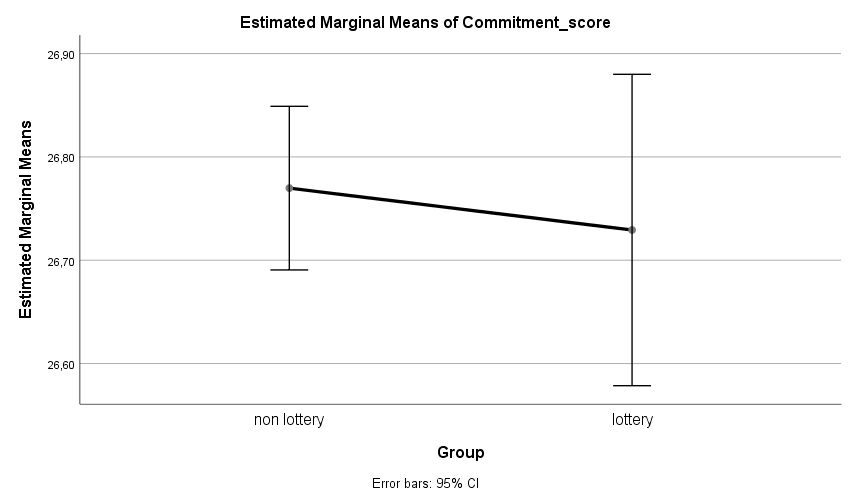
The effect of age on commitment
The graph below is worth showing you as it highlights how commitment can change by age group. The chart shows the scores for both lottery and non-lottery combined and very clearly declines over time. And while the middle age bands are not significant, the differences between the under 44’s and the over 65’s are statistically significant.

The chart below shows overall commitment by age band, but with lottery and non-lottery supporters show separately. Interestingly for both lottery and non-lottery supporters commitment declines with age. However among the younger age bands commitment is higher among non-lottery supporters, but past 65 commitment is higher among lottery players.
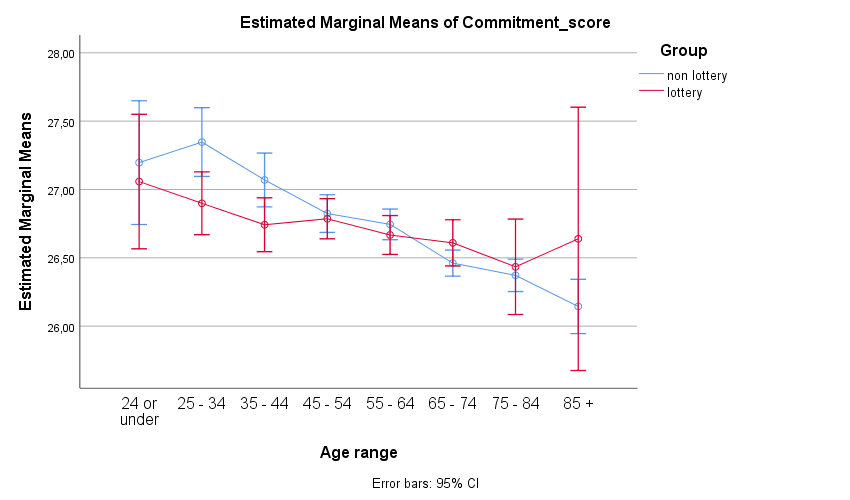
Understanding commitment in more detail
As I explained, we measure commitment by combining the scores for six different ways supporters evaluate their relationship with a charity. There are obviously many more factors supporters may evaluate but over time we’ve identified these six to be the most discriminating from those factors we’ve explored.
So rather than look at the overall commitment score we wanted to identify any differences between lottery and non lottery supporters for the six factors that go into commitment. Here we did find some interesting differences, including those below.
(1) ‘I have a clear idea of what charity x is trying to achieve’

Interestingly, we can see that lottery supporters have scored this higher and to a statistically significant level. It’s a fascinating (and somewhat surprising results) and as yet we don’t understand why!
We wondered if it was because of differences between age bands but I found no significant differences – all groups are quite similar, although there is a faint decline overtime.
(2) ‘I know my support for charity X is making a difference’
Non-lottery supporters have a significantly higher score than lottery supporters. Part of the explanation for this may be the communication strategy in place for each group with pure cause supporters receiving far more frequent and in-depth explanations concerning how their money has been used and the impact their support is having. So it’s great to see that with careful messaging we can improve the scores for this vital perception of the supporter experience.

With regards age, we see an interesting pattern – scores hold up well until post 65 when they then decline with each age band.

Comparing age bands for lottery and non-lottery supporters we see that they both have a similar overall pattern, however the difference in scores is far more significant among younger bands with non lottery supporters having far higher scores. It suggests there’s some work to be done to improve how the charity communicates impact among the older groups, regardless of whether lottery or non lottery.
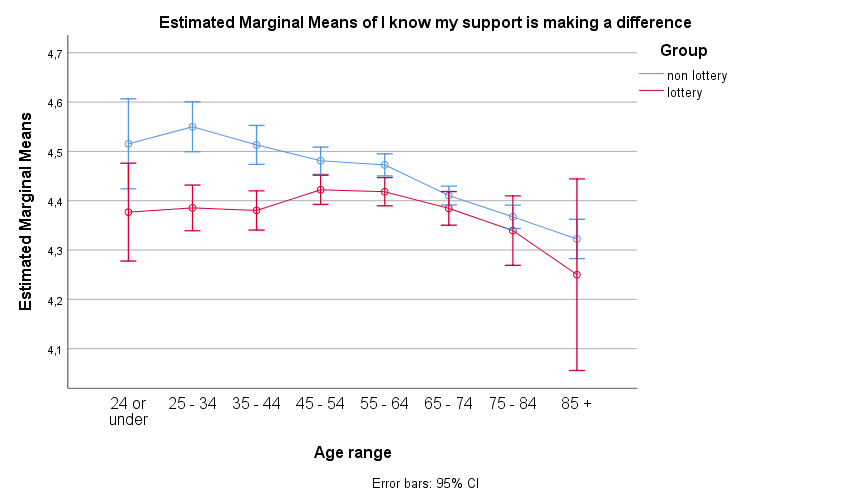
(3) ‘Charity x makes me feel involved with the organisation’
Over the past nine years, across all the charities we’ve carried out this research ‘making me feel involved with the charity’ is consistently scored far lower than other factors, such as trust. But for the first time we can identify that there is a statistical difference with non-lottery supporters scoring the charity much higher than lottery supporters. As with ‘making a difference’ this may be a result of the communications programme being more frequent but also designed to build a better bond between supporter and charity.
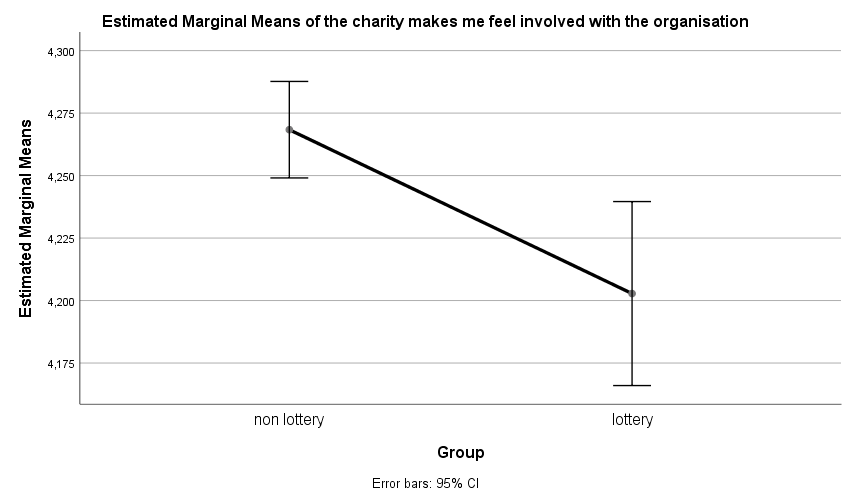
As we can see in the charts below, they follow a very similar pattern to the other factors we’ve looked like, with higher scores among the younger supporters.
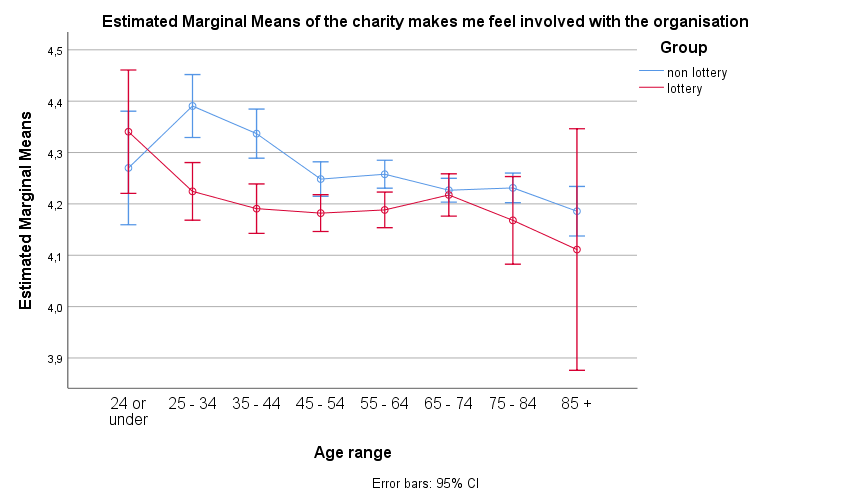
The impact on legacy
In the past for every study into this area we’ve identified that there is a very positive relationship between commitment to a charity and legacy potential.
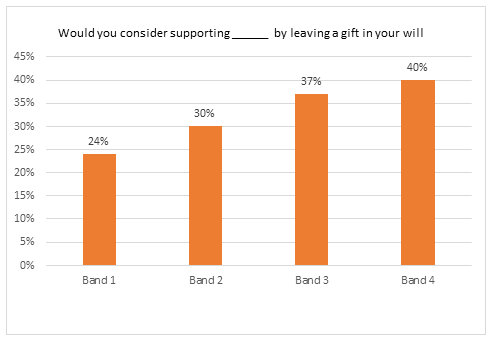
So I wanted to look at whether as many lottery players would claim they would be interested in leaving a legacy to the charity, as non-lottery players. Our finding was that lottery players showed less probability of saying they would consider leaving a legacy than non-lottery supporters, HOWEVER the size of the difference was very low.
The conclusion for legacy is that if you were to promote legacy giving to both lottery and non-lottery supporters, then without any other selection criteria the non-lottery supporters should perform slightly better.
However, if you were to overlay many of the typical additional selection criteria you would normally use for legacy targeting (e.g. age, tenure and value) then you will be able to get a performance for lottery supporters that mirrors non-lottery supporters.
Summary
Despite the growing use of lottery and raffle products within individual giving programmes there has been a lack of evidence regarding any differences between lottery and raffle supporters (gaming supporters) and ‘pure cause’ supporters. The story from this study is that there is no statistically significant evidence that lottery players are less committed to supporting the charity, than ‘pure cause’ supporters.
However, there are some significant differences between the groups (and noticeable across age bands) for each of the six factors we examined. Some of which were very surprising.
Age is clearly important in affecting the scores, so if you intended to repeat this exercise or similar we would recommend ensuring you take into account the age of supporters.
Implication
For too long fundraisers have seemingly adopted the view that the two types of supporters are almost different species of supporters, and that there is a tension between how they are treated and how they can benefit the charity. It’s time to rid ourselves of any perceptions towards gaming supporters and consider their expectations, motivations and supporter needs just as much as we do for pure cause supporters.
